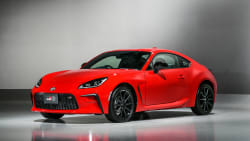The Prius Prime

Is it PRIME time for the Prius?
The Prius has been around forever - at the forefront of the hybrid-revolution. With the Prius Prime Toyota makes sure to keep up with the times and technology of today.
By Roy Nakano
Wed, Feb 2, 2022 11:30 AM PST
images courtesy Toyota.
I still remember watching then GM Vice Chairman Bob Lutz respond to questions as the Motor Press Guild’s keynote speaker during the 2003 Los Angeles Auto Show. Someone asked him about Toyota’s new Prius. “There’s no business case for hybrid cars,” was his dismissive response. The Prius then proceeded to eat away at domestic car sales, winning a whole slew of awards along the way.
Two years later, Bob Lutz admitted that GM missed the boat on hybrid marketing. “We business-cased it, took a hard, analytical look and thought the engineering and investment were irresponsible vis-a-vis our shareholders. We failed to appreciate what Toyota has basically treated as an advertising expense.”
What Lutz was saying is that while hybrids were not sufficiently profitable, the Prius was great public relations for Toyota. It made consumers perceive Toyota as a company helping to save the planet. Said Lutz, "Toyota very cleverly has used hybrids to gain an improved perception of the brand." Bob Lutz still didn’t get it quite right, but more on that later.

The Hybrid Revolution
While the Prius had been in production since 1997 and entered the U.S. market in 2000, it wasn’t until the New York International Auto Show in April of 2003 when the industry really took notice of the car in a big way. That was the time Toyota introduced the second-generation Prius, with the now familiar triangular silhouette and a claimed estimated EPA fuel economy rating in the 50 miles per gallon region.
In late 2003, the second-generation Prius reached the shores of the USA and took the country by storm—both commercially and critically. It captured just about every automotive magazine Car of the Year award for model year 2004. The EPA confirmed a fuel economy rating of 51 miles per gallon on the highway and an even higher 60 miles per gallon in the city (later, the EPA would adjust its way of measuring fuel economy for all cars to come closer to real world results, rendering a more realistic 45 mpg highway and 48 mpg city rating for the Prius).
The Prius became an overnight sensation. Celebrities began buying the Prius as an environmental status symbol. Movie stars would arrive at red carpet ceremonies, chauffeured in a Toyota Prius. Competitors scrambled to introduce their own hybrid models. Hybrid technology even spilled into motorsports. Today, virtually all the top cars at the 24 Hours of Le Mans endurance race are hybrids. The hybrid revolution was complete, and Toyota vowed to offer hybrid versions of their entire line-up of models.

The Prius in the Post-Hybrid Era
Oh, what a difference 20 years make! It started around 10 years ago, with the introduction of the Tesla Model S—the first all-electric passenger sedan capable of traveling 200 miles on a single charge. Soon, others followed the battery electric vehicle revolution. Toyota, however, has been late to the party—choosing instead to stay with hybrids and banking on fuel cell electric vehicles for the future over battery electric vehicles. Only now has Toyota pivoted toward battery electric vehicles, with the anticipated introduction of the 2023 Toyota bZ4X.
Meanwhile, Toyota has been honing the Prius down to a razor’s edge. Now in its fourth generation, the new Prius is even stingier on a gallon of gas, has more responsive steering and handling characteristics, and rides quieter.
And then there’s the Prius Prime. The most electrified Prius of them all, the Prime is the plug-in version of the Prius hybrid electric vehicle. It’s a considerable leap forward over the previous generation Prius Plug-in Hybrid, which was capable of going about 11 miles in pure electric mode before the internal combustion engine kicked in. The Prius Prime more than doubles the electric range, to 25 miles.

Still, it’s not enough to meet the recently revised California Clean Vehicle Rebate Project that requires plug-in hybrids to have an EPA range of at least 30 miles in all-electric mode. For those in California, this impacts ones ability to enjoy a heftier rebate from the state.
The good news is the Prius Prime still meets the Transitional Zero Emissions Vehicle (TZEV) standards for California’s High Occupancy Vehicle lane access. So for a fee of $22, you can apply for carpool lane access even if you’re the only person in the car. California’s current program will get you a set of yellow access decals good through January 1, 2025. Moreover, the Prius Prime still qualifies for a federal tax credit.
So, how does the Prius Prime perform?
Like a very good Prius, which is to say it’s even more fuel efficient (in pure electric mode, it requires NO gas), rides better (the weight of the battery pack makes the car feel more planted), feels more refined (there’s a considerable upgrade to the interior), and goes a bit farther on a single tank of gas (640 miles, according to the EPA estimates). In addition, the Prime model discards the goofy-looking catfish snout of the regular Prius in favor of a more pleasing front end, along with a distinctive, full-width taillight treatment.
On the other hand, the Prime is still a Prius. You won’t likely win any stoplight drag races in it. Like the regular Prius, the Prime behaves best when driven by a driver that behaves. It’s not happy speeding. If you try to push the car to its limits, the continuously variable automatic transmission will moan in protest. Drive like you’re not in a hurry, and the car will reward you in serenity, not to mention good fuel economy. Like the regular Prius, driving the Prime will make you a more obedient driver. It’s one of the Prius hallmarks.

Versatility
It’s another Prius hallmark. That hatchback design can swallow up all manner of items, particularly with the back seat down. A good-size, multi-drawer desk can go back there—with the hatchback lid shut. I even fit a twin bed mattress, its box spring and frame in the Prius while helping someone move.
And there’s plenty of room for passengers. It’s telling that the EPA classifies the Prius as a mid-size car, and not a compact car. There’s ample legroom for rear passengers, and that unique triangular silhouette of the car means drivers and front passengers can wear their hats with room to spare.
You can get the Prime for less than a regular Prius.
When factoring in the tax and cash rebate incentives, the Prius Prime is actually cheaper than its equivalent regular Prius. The regular Prius LE goes for $25,835 (there’s a stripped L Eco model for $24, 625 that’s not as well-equipped as the LE). The Prius Prime LE goes for $28,220, but there’s a $4,502 federal tax credit available. Assuming one qualifies for the tax credit, that brings the price of the Prime down to $23,718. If you live in California, you may be eligible for an additional $1,200 cash rebate, bringing the Prime down even further to $22,518.

Prime Time for the Prius
In recent years, Toyota has been refining the Prime even further, with more standard safety features, Apple CarPlay and Android Auto now standard, two USB ports in the rear, and the rear seat reconfiguration to allow a fifth passenger. Toyota has also been offering incentive on the Prius Prime, including cash incentives and incentives for recent graduates and military personnel families. You’ll want to keep an eye out for them on the Toyota site.
In answer to the question at the beginning of this story, it IS prime time for the Prius. And if you’re in the market for a Prius, there’s no reason to get anything other than the Prime. After factoring in the tax incentives and rebates, it’s the cheapest one you can buy—almost as cheap as the second-generation Prius when it was introduced in the fall of 2003! Add to that, you get a car that qualifies for single-occupancy driving in California’s carpool lane. It’s prime time for the Prius Prime.
Specifications (The Ones That Matter)
Name of car: 2022 Toyota Prius Prime
Price: $28,220 (LE), $30,000 (XLE)
EPA size classification: Midsize
Propulsion: Plug-in hybrid electric vehicle, with 1.8-liter four-cylinder internal combustion engine with lithium battery-powered electric motor.
Drive configuration: Front-wheel drive
0-60 mph performance (estimated): 10 seconds
Tax and cash rebate incentives
(restrictions may apply)
$4,502 federal tax credit
$450 California Clean Fuel Reward Rebate
up to $750 for an additional California Clean Fuel Reward Rebate from your utility company
EPA fuel economy rating
54 MPG combined city/highway
133 MPGe combined city/highway
640 mile total range
For further information on the Prius Prime, visit the Toyota site at toyota.com.
About The Author

Roy Nakano gave birth to LACar in the late '90s, having previously delivered LA Audio File back in the '80s. Aside from the occasional review, Roy likes to stray off the beaten automotive path: "Six Degrees of Reparations" reflected on the regretful ethical paths taken by car companies throughout history. "Traveling Through the Past and Present of the Green Book" looked at businesses that took a stand against racism and the man that wrote the book on where to find them. "Best Cars to Drive in Rush Hour Traffic" was an LACar guide published in the pre-GPS era. "In Search of the First Datsun 510 Tuner" looked at one of the milestones in the origin of import tuners. And "Us vs Them" examines the instances when rivalry among automotive enthusiasts crossed the line to violence and even death.






